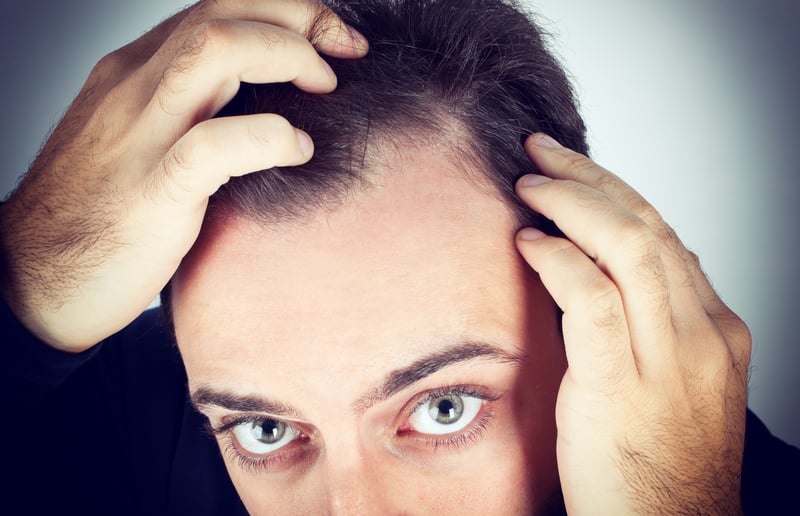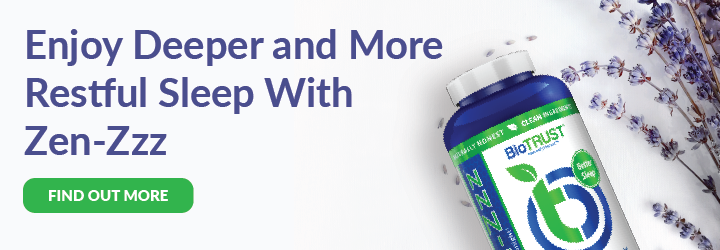14 Signs You Could Be Suffering from a Vitamin Deficiency

If you’re eating a healthy, well-balanced diet, you should be getting all of the nutrients your body needs. But in today’s busy world, it’s easy to see why convenience sometimes (or more likely, often) wins out when it comes to our food choices. Plus, if battling a health issue or just choosing to lose weight, you may also start restricting entire food groups, which can again make it more difficult to get all of the nutrients the body needs. And that could lead to a vitamin deficiency.
Serious vitamin deficiencies are very rare in our society, but they do happen. In fact, according to the Centers for Disease Control and Prevention, in the U.S., up to 10.5% of the population is deficient in vitamin B6, 8.1% don’t get enough vitamin D, 6% are deficient in vitamin C, and around 1% lack enough vitamin A. 1 So it’s worth knowing what to watch for as your body will provide signs when it’s missing key nutrients.
Here are some of the signs to watch for and what your body may be telling you.
- Brittle Hair or Nails
- Mouth Ulcers/Lesions
- Red, Bleeding or Swollen Gums
- Burning Sensation in the Tongue or Feet
- Night Blindness or Dry Eyes
- Dandruff and Dry Itchy Skin
- Bruising or Slow Wound Healing
- Bumpy Skin
- Pain in the Bones
- Hair Loss
- Muscle Cramps
- General Fatigue
- Acne
- Less Restful Sleep
14 Signs of Vitamin Deficiencies
1. Brittle Hair or Nails
Most Likely Nutrient Needed: Biotin (Vitamin B7)
Brittle nails and hair can result from being in a dry environment, washing frequently (which can strip away oils), or it could be a sign that you aren’t getting enough of the nutrient vitamin B2.
Fortunately, this type of deficiency is very rare. But if you notice that your hair and nails are brittle, thinning, and/or splitting, especially if you also feel tired all the time, suffer from muscle pain or cramps, or if your hands and feet begin to tingle, then it may be a good idea to look at your diet to ensure you are getting enough biotin. 2
A deficiency is more likely for heavy smokers or drinkers, as well as people with Crohn’s disease or other digestive disorders, or people who use antibiotics or anti-seizure meds for an extended period. Deficiencies can also result in individuals who consume lots of raw egg whites as they contain a protein (avidin) that binds to biotin, decreasing its bioavailability. And nearly half of pregnant women may suffer from a mild deficiency. 2
If you are experiencing brittle nails or hair, you may want to choose a more moisturizing shampoo or soap and drink more water. But if it is related to not getting enough biotin, you can increase the amounts your body is getting as it’s readily available in numerous foods such as egg yolks, meat, dairy, nuts and seeds, bananas, cauliflower, broccoli, spinach, sweet potatoes, and whole grains. There are also biotin supplements available, with the recommended amounts being just 30 micrograms per day. However, most research indicates the best way to get this valuable vitamin is from the foods you eat. 2
2. Mouth Ulcers/Lesions
Most Likely Nutrient Needed: B Vitamins or Iron
If you start noticing that the corners of your lips crack or bleed or if you start developing canker or cold sores frequently, it could indicate you aren’t getting enough B vitamins (such as thiamin/B1, riboflavin/B2, or pyridoxine/B6) or iron. 3, 4 It could also be a sign that you’re dehydrated. 5
Make sure you’re drinking plenty of water as well as getting foods that provide a rich amount of iron and B vitamins, such as poultry, meat, fish, beans and legumes, dark leafy greens like spinach and kale, nuts and seeds, and whole grains.
3. Red, Bleeding or Swollen Gums
Most Likely Nutrient Needed: Vitamin C
In today’s day and age, if your gums are bleeding, it’s most likely going to be improved by ensuring you have good oral hygiene. Use a soft toothbrush and don’t brush too aggressively, floss daily, and ensure you are getting regular dental checkups.
You may also want to check in with your diet. Vitamin C is a vital nutrient that is needed for protecting against colds, flus, and other infections as well as healing wounds and protecting against cell damage as an antioxidant. Vitamin C is essential as our bodies don’t make it: we need to consume it through the foods we eat. 6
Most of us are at a very low risk for a vitamin C deficiency as it’s found abundantly in many vegetables and fruits. But if you tend to skip the green stuff and aren’t a fan of fruits, then you could be at risk. In fact, studies have found that between 13 and 30% of people have low vitamin C levels, and up to 17% of folks are deficient. 7
If you aren’t getting enough vitamin C, you can experience bleeding or swollen gums and eventually the loss of your teeth. 8 You can also experience a depressed immune system, muscle weakness, bone loss, and just feeling sick and tired—which together may indicate scurvy. (Yes, people in the U.S. can still be diagnosed with this disease.) Other signs of a vitamin C deficiency include bruising easily, dry skin, regular nosebleeds, and slowed healing.
Fortunately, minor dietary changes can help you get enough vitamin C. Start by eating between three and four servings of vegetables and at least two servings of fruit each day.
4. Burning Sensation in the Tongue or Feet
Most Likely Nutrient Needed: Vitamin B12
If you start feeling like your tongue or feet are burning, you should check in with a doctor for a blood test. Low vitamin B12 could be the culprit. A deficiency can also cause issues with balance, constipation and other digestive issues, dry skin, and changes in memory, thinking, or behavior.
Because plant-based diets tend to eliminate foods that are rich in B12 (such as meat and dairy), it’s important to get it from other sources if you are following that type of diet. Many milk-like beverages (e.g., soy, almond, or coconut milk) are fortified with vitamin B12. And it can also be found in nutritional yeast.
Again, vitamin B12 is essential as the body is unable to create it. So, you must get this nutrient from foods or supplements.
5. Night Blindness or Dry Eyes
Most Likely Nutrient Needed: Vitamin A
Throughout our lives, our vision changes. Especially as we get older, we can find we don’t see like we once did—especially at night. A poor, nutrient-depleted diet, however, can make it much worse and even lead to blindness if not addressed, even if you are still young.
If you do find that it’s more difficult to see in low light or that your eyes are often dry, it could be a sign that you aren’t getting enough vitamin A. 9 Vitamin A is needed for the production of “rhodopsin,” which is a pigment around the retinas that helps you see when it’s dark.
If a vitamin A deficiency continues for a long time, it can cause xerophthalmia, which causes cornea damage and potentially full blindness. 10 In early stages of the disease, you may see indications as white, “foamy” growths on the whites of the eyes. Once an individual begins getting enough vitamin A, these growths tend to go away.
If you are concerned that you aren’t getting enough vitamin A to support your eye health, ensure you are eating foods like eggs, fish, dairy, dark leafy greens, yellow-colored vegetables (like carrots, cantaloupe, and tomatoes), and organ meats, which are all rich sources of this nutrient.
Unless you have been officially diagnosed with a vitamin A deficiency and are being treated by a health-care professional, avoid any vitamin A supplements, as it is also common to consume too much of this vitamin. Because it’s a fat-soluble vitamin, if you get too much in the body, it can become toxic, which can cause nausea, headaches, bone and joint pain, skin issues, and even coma or death.
6. Dandruff and Dry Itchy Skin
Most Likely Nutrients Needed: Biotin, Zinc, Niacin/Vitamin B3, Riboflavin/Vitamin B2, Pyridoxine/Vitamin B6, or a Combination of Nutrients
Up to 42% of infants and up to 50% of adults deal with dry, itchy, flaky skin on the head (dandruff) or body at some time in their lives. 11, 12 Also known as “seborrheic dermatitis,” this condition can be caused or made worse by a number of different factors, including nutrient deficiencies, dehydration, or the skin and haircare products you choose.
If dry, scaly skin on the scalp, eyebrows, or other area of the face, ears, or chest are common, your diet may be lacking in key nutrients like zinc and several B vitamins. 12
To help combat this dry skin, ensure you’re consuming a wide variety of whole foods as well as plenty of water. Foods rich in zinc include seafood, meat, legumes, dairy, nuts, and whole grains. Foods that provide an abundance of B vitamins include whole grains, poultry, meat, fish, eggs, dairy, legumes, nuts and seeds, and green leafy vegetables.
RELATED: Collagen Doesn’t Work (Unless…)
7. Bruising or Slow Wound Healing
Most Likely Nutrient Needed: Vitamin C
Vitamin C has so many important functions in the body. It acts as an antioxidant to fight free radicals and limit cell damage, it can help the body fight inflammation, it can help pull the cells together and boost collagen levels, so wounds, including bruises, can heal faster. Too little vitamin C can also lead to increased signs of aging like wrinkles and decreased elasticity of the skin.
Ensure you eat a diet rich in vitamin C by consuming plenty of vegetables and fruits like kiwi, bell peppers, and oranges. If you have been experiencing signs and it is related to vitamin C levels, improvements are typically enjoyed fairly quickly, within a few days to a few weeks.
8. Bumpy Skin
Most Likely Nutrients Needed: Vitamins A and C
Another common skin condition is little red or white bumps that show up on the cheeks, arms and legs, or butt. They’re known as keratosis pilaris (aka chicken skin) and they can come alone or combined with ingrown hairs. These bumps are more common in children, which disappear as kids grow up and become adults, but they can happen to people at any age.
There appears to be a genetic component, but it may also indicate a diet low in two key vitamins: A and D.
Medicated creams are typically recommended, but eating more foods that provide high amounts of vitamins C and A may also help. Foods to consume include eggs, dairy, fish, dark leafy greens, orange-colored vegetables, and a variety of fruit.
9. Pain in the Bones
Most Likely Nutrient Needed: Vitamin D
Growing pains should end once you’ve stopped growing, so if your bones start feeling painful, especially in the pelvis, lower back, and legs, one potential cause is a vitamin D deficiency.
Vitamin D is found in salmon, sardines, canned tuna, shrimp, and mushrooms. Some foods, like milk, orange juice, and oatmeal, are also fortified with vitamin D. However, one of the best ways to get vitamin D is to simply spend about 10 minutes in the sun at least a few times a week without sunscreen. Make sure, however, that you add sunscreen if you’ll be out longer to prevent UV damage.
10. Hair Loss
Most Likely Nutrients Needed: Zinc, Iron, Linoleic Acid, Alpha-Linolenic Acid, Niacin/B3, Biotin/B7
Hair loss becomes more common as we age, especially once we hit 50 years old. In fact, up to 50% of adults (men and women) can experience hair loss by this age. 13 Fortunately, a nutrient-rich diet may help stave off or minimize hair loss.
Not getting enough iron, for instance, can prevent hair from growing or even lead to hair loss. (Other signs that you aren’t getting enough iron include feeling cold constantly or experiencing headaches or dizziness.) Zinc is needed for hair growth due to its role in protein synthesis and cell division. Linoleic acid and alpha-linolenic acid are essential fats needed for hair growth. Niacin helps keep hair healthy and not getting enough can cause hair to fall out in patches (known as alopecia). Finally, biotin helps hair stay strong and healthy. 14
Foods that provide these nutrients include meat, fish, dairy, eggs, legumes, nuts and seeds including flaxseeds and chia seeds, whole grains, and dark leafy greens.
Some vitamins and minerals, when taken in excess, however, can also lead to hair loss. These include selenium and vitamin A. So, use caution if supplementing to prevent hair loss.
11. Muscle Cramps
Most Likely Nutrients Needed: Iron or Magnesium
Restless leg syndrome (aka RLS or Willis-Ekbom disease) is characterized by an irresistible urge to move the legs along with strange, unpleasant sensations, especially as you’re relaxing or trying to get some shuteye. The condition affects nearly 10% of people in the U.S. with women experiencing it nearly twice as often as men.
Researchers are still studying what causes restless leg syndrome, and the condition is not clearly understood. However, there may be a link to how much iron is in the blood. 15 Studies have found, for example, that when there are low iron stores in the blood, symptoms can increase. Restless leg syndrome is also more common in women when they’re pregnant. 16 And many women see a decreased iron level during pregnancy.
Foods rich in iron include meat, poultry, fish, legumes, leafy greens, nuts and seeds, and whole grains. You can also get more iron in the body by cooking with cast-iron pots and pans. Your body may better absorb the iron found in foods when it’s combined with vitamin C-rich vegetables and fruits. Avoid consuming tea or coffee with your iron-containing foods, though, as that may impede absorption.
There are iron supplements available; however, supplementation should be done only with guidance from a health-care professional as these types of supplements have been shown to decrease the absorption of other nutrients. Plus, high iron levels can also have serious or even fatal effects beginning with frequent vomiting and diarrhea. 17
Low iron, though, isn’t the only potential link to restless leg syndrome. Some research has indicated magnesium may play a role and increasing consumption has led to improvements for some folks who had experienced mild to moderate signs. 18
Not getting enough magnesium may also lead to muscle cramps or spasms as well as weaker bones or even nausea.
Magnesium can be found in avocados, leafy greens, bananas, nuts and seeds, legumes, tofu, whole grains, some fatty fish, including salmon, mackerel, and halibut.
12. General Fatigue
Most Likely Nutrients Needed: Iron, Vitamin B12, Omega-3 Fatty Acids, or Vitamin D
This is admittedly a very broad sign with potentially endless factors—from not getting enough sleep to stress and more. Another potential reason the body may feel tired, though, could be related to a nutrient deficiency.
Eating a healthy, whole-food, nutrient-dense diet should be one of the first steps to addressing fatigue. Even if your fatigue is related to increased stress or a rough night’s sleep, a quality diet may help.
13. Acne
Most Likely Nutrient Needed: Zinc
Pimples, blackheads, white heads… i.e., acne, can be caused by hormonal changes, but it can also be a sign that the body is low in zinc. Zinc is a mineral that helps support a balanced immune system as it helps the body fight inflammation and infection.
Zinc can be found in red meat, shellfish, legumes, seeds and nuts, dairy foods, eggs, whole grains, and even some vegetables like potatoes, green beans, and kale.
14. Less Restful Sleep
Most Likely Nutrient Needed: Vitamin D
If you find that you’re sleeping less or the sleep you are getting just doesn’t feel as restful and restorative as expected, it could also be related to a lack of vitamin D. Low D levels have been associated with sleep disorders, decreased sleep quality, shorter sleep duration, and daytime sleepiness. 19
Signs of Vitamin Deficiencies: A Wrap-Up
Serious vitamin deficiencies are rare in our society, but they can happen, so it’s a good idea to know what signs your body may be giving you if you aren’t getting enough, even if mild or moderate.
The best option to avoid nutrient deficiencies is to ensure you’re eating a wide variety of foods, especially vegetables, fruits, beans and legumes, seafood, and meats from time to time. If you do want to stick with a plant-based diet, just be aware of the potential decreased nutrients, so you can get them from other sources.









